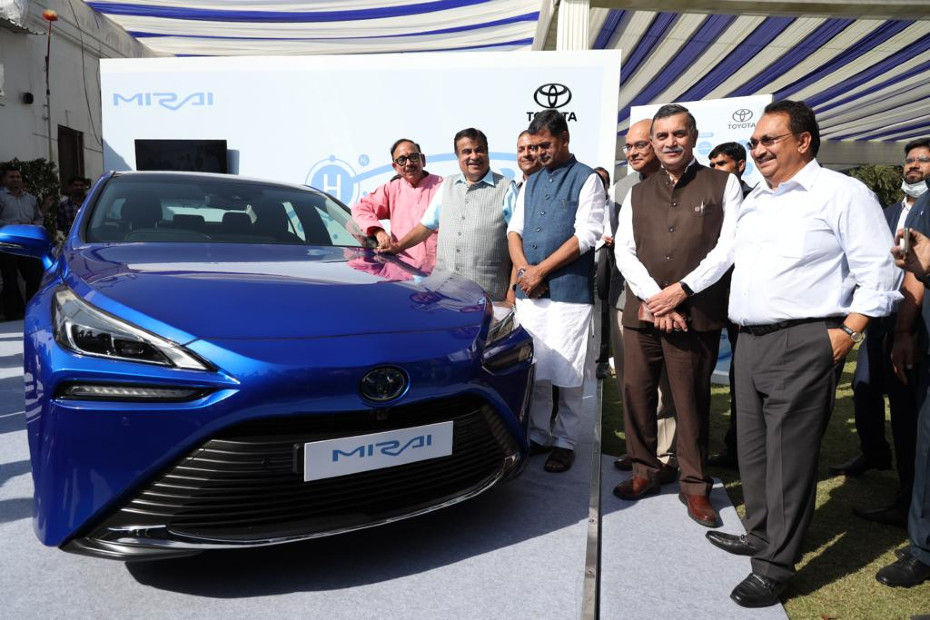Nitin Gadkari Finds Out How The Toyota Mirai Works As A Daily Driver
Modified On Mar 31, 2022 05:24 PM By CarDekho
- Write a comment
The transport minister has said that India will produce and even export green hydrogen for fuel cell cars in the future

As the Indian market warms up to electric vehicles (EVs), it seems like more alternatives to all-electric cars might be on the horizon. Transport minister Nitin Gadkari, in a continuing push for hydrogen fuel cell electric vehicles (FCEVs), has been using a Toyota Mirai pilot study car as a daily driver. Watch him being driven around Delhi to spread awareness of FCEVs:
The Toyota Mirai is an electric sedan that rivals the Tesla Model S in other countries. It’s powered by a 182PS and 406Nm electric motor that draws energy from a 1.24kWh battery pack. It offers a range of 646km on a single tank of hydrogen fuel – about 5.6kg of H2 gas. What's more, it producing only water vapour as an emission!
What makes FCEVs different from regular EVs?

Electric vehicles are driven by electric motors and draw their energy from a battery pack that needs to be recharged with electricity by plugging into a power source. FCEVs are also propelled using electric motors, but instead of a large battery pack, they have a relatively small battery pack that’s paired with a hydrogen fuel cell.

The fuel cell uses the energy released from the reaction between hydrogen and oxygen to generate electricity. FCEVs store hydrogen gas under high pressure in a sealed tank, which makes refuelling as easy, quick and familiar as filling up at a petrol, diesel or CNG pump.
Here’s how hydrogen cars compare with real-world EVs in terms of efficiency:
| Toyota Mirai |
Jaguar I-Pace |
|
|---|---|---|
| Battery Size |
1.24kWh |
90kWh |
| Charging/Refueling Time |
5 minutes |
40 minutes (at 150kW) 1 hour 10 mins (at 50kW) |
| Driving range |
646km |
470km |
| Vehicle weight |
1,930kg |
2,208kg |
The above table highlights the two main advantages of FCEVs. One, they can be made lighter than electric cars without impacting range figures, since there’s no need for a hefty battery pack. Two, they can be refuelled much more quickly than electric vehicles without needing high-wattage public chargers.

The transport minister had announced the FCEV pilot project earlier in March to evaluate the feasibility of the technology in the Indian context. He has emphasised that FCEVs will be fuelled by green hydrogen in the country, and aims to make India capable of exporting green hydrogen.
India will soon become Green Hydrogen exporting country. In line with PM Shri @narendramodi ji’s vision of clean and cutting-edge mobility in India, our government, through ‘National Hydrogen Mission’ is committed to focus on green and clean energy. pic.twitter.com/FOQ9pHznfh
— Office Of Nitin Gadkari (@OfficeOfNG) March 30, 2022
What is green hydrogen?
Depending on the source, there are three forms of hydrogen that are produced around the world – grey, blue and green. The least environmentally friendly option is grey hydrogen, since it’s produced from natural gas and releases carbon dioxide into the atmosphere during its production. Most of the hydrogen produced globally is grey hydrogen.

Green hydrogen is the H2 that is produced using renewable sources of energy. It is relatively rarer, since high-yield sources are hard to find, and the overall demand for the fuel is already met by less eco-friendly sources.
With a global shift towards reducing overall carbon emissions, the demand for FCEVs, and importantly, green hydrogen, can only be expected to rise in the coming years.

Nevertheless, even grey hydrogen-fueled FCEVs are on par with electric vehicles in their lifetime carbon emissions. The technology is promising, but the choice for car buyers is scant – only two FCEVs, the Hyundai Nexo and Toyota Mirai – are on sale in global markets.
-
Ratan Tata's New Car Is A Custom-made Electric Nano Built By Electra EV
-
Hydrogen-powered Hyundai Nexo Electric SUV Gets Approval In India
In addition, hydrogen cars can be costly – even more so than fully electric vehicles. For example, in the German market, the Mirai retails from the equivalent of Rs 54 lakh onwards, while the Nexo has a starting price of Rs 65 lakh. These vehicles are likely to be imported as completely built-up units if introduced in India, which is likely to drive their price past Rs 1 crore in our country.

On the other hand, hydrogen and fuel cell technology is being developed for non-car forms of transportation, too. In the race for lower emissions, alternative sources such as hydrogen are likely to be helpful, even if FCEVs aren’t the last word in EVs.
1 out of 1 found this helpful















